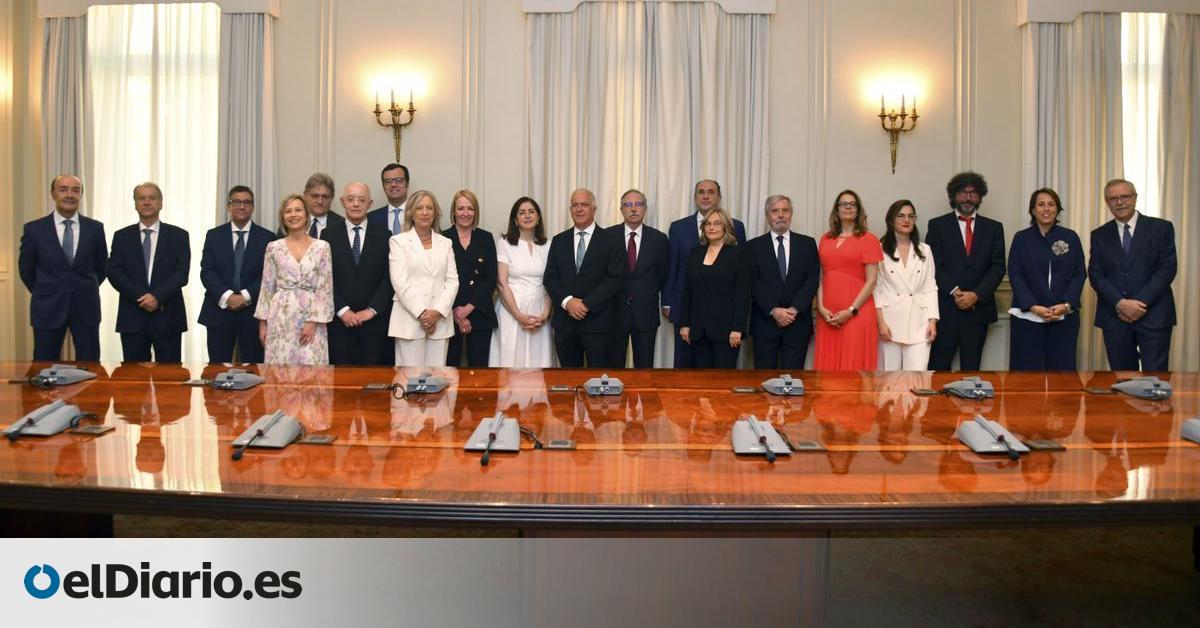
The clouds of blockage are once again looming over the General Council of the Judiciary (CGPJ) at the start of August, despite the fact that its 20 new members have just been appointed. After the first two meetings, its first major task, renewing the presidency, has caused total disagreement between progressives and conservatives and both sectors rule out that the next meeting, scheduled for next Monday, will change anything. The progressive sector hopes that a woman will preside over the CGPJ for the first time and the conservatives refuse, arguing that the candidate proposed after the respective screening, Pilar Teso, has less merit than their candidate, Pablo Lucas.
The course of the first negotiations has suddenly brought down the curtain of good will and has revealed the political battlefield that is the Judiciary. It has also revealed how the Popular Party wants to control the CGPJ when it has a majority in Congress and also when it does not.
The progressive sector of the judiciary was greeted with concern that the Government had handed over ten members to the conservatives, after almost six years of blocking the renewal, because the Popular Party, changing excuses aside, did not want to give up control of the governing body of the judges, as it had done in its five years of mandate as a result of Mariano Rajoy’s absolute majority and in the following five in which it refused to renew it.
The first consequence of this concession is being experienced in these days of the first CGPJ, where the two blocks act in a rocky manner and close themselves off to the proposal of the other. The fact that both have ten members explains the importance that conservatives and progressives give to making one of their own president and that he can in the future, and pending changes in the law, settle the disagreements with his casting vote.
The last meeting between the 20 new members of the Council last Wednesday ended without agreement. Nor did it foresee any rapprochement between two positions that are irreconcilable, at least for now, despite the fact that the two candidates have a similar curriculum, although Pilar Teso’s is more extensive in the judicial field. The judge has been part of the Third Chamber of the Supreme Court since 2008 and joined the career in the eighties, while Pablo Lucas worked as a professor and technician in the Council itself before taking up the Supreme Court’s robes, in the same chamber, appointed by the governing body of the judges in 2001.
In the event that the next meeting once again stages the blockade, the new CGPJ will hold one or two meetings during the month of August, via telematics, to resolve procedural issues, such as licenses and permits. One voice from the Council, however, defends the work of the new members and demands that they not be required to reach an agreement that “the politicians have taken five years to reach.”
New vote with seven candidates
The members will meet again next Monday, August 5, to try to unblock the situation, but for the moment none of the sectors sees it possible to reach an agreement before September. Given the two successive ties between Teso and Lucas, the plenary will have to face new negotiations and votes but with the seven original candidates on the table. Candidates who, despite having been proposed by some of the members, have not received a single favorable vote, not even from those who proposed their names.
The progressive faction’s list of candidates is completed by Ana Ferrer, the first woman to enter the Supreme Court’s Criminal Chamber and who was part of the court that sentenced the Catalan independence process. Also by Ángeles Huet, one of the latest additions to the High Court’s Contentious-Administrative Chamber in 2020.
As for the conservative candidates, who also did not receive any votes during the first two meetings, there are Antonio del Moral and Carmen Lamela, Ferrer’s colleagues in the second chamber, and Esperanza Córdoba, a member of the third chamber along with Huet, Lucas and Teso.
The strategy of the conservative sector of the governing body of the judges to condition the election of senior officials to the limit reached its climax at the end of last year, when the members of this faction managed to get the progressive sector to change its candidate for the Constitutional Court and instead of José Manuel Bandrés, the chosen one was María Luisa Segoviano. Weeks of negotiations and blockage in which the conservative sector went so far as to propose Pablo Lucas as a magistrate of the Constitutional Court, a proposal that has been repeated in the debate to renew the presidency of the General Council of the Judiciary.
Pilar Teso is the only woman who has opted to preside over the governing body of judges in its four decades of history. To date, all the presidents have been men and all her rivals, when there have been any, have also been men. Teso was first proposed in 2013, when she lost the vote to Carlos Lesmes with a Council with a conservative majority.
Source: www.eldiario.es

